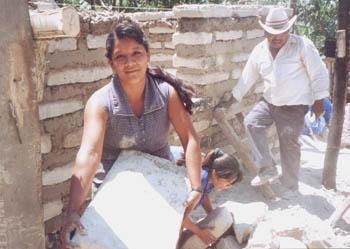![[Metroactive Movies]](/movies/gifs/movies468.gif)
[ Movies Index | Show Times | San Jose | Metroactive Central | Archives ]
Aftershocks
Documentary about destruction in El Salvador focuses on recovery
By Tai Moses
NATURAL DISASTERS that occur in developing countries don't hold the attention of the American news media for long. After a scant four months, for instance, the Jan. 13, 2001, earthquake that rocked El Salvador seems like a distant memory--in the United States. To the Salvadorans still digging their lives out of the rubble and laboriously rebuilding their country, the earthquake and its aftermath are very much a part of daily life.
The tiny, quake-ravaged country is the subject of Felton filmmaker Bob Gliner's new documentary, El Salvador: Crisis and Challenge. Troubled regions of the world are nothing new to Gliner; the San Jose State University professor of sociology has filmed 33 documentaries in countries like Macedonia, Vietnam and Cuba, and locally on topics from inmate conditions in Soledad to the challenges faced by today's high school students. He seems magnetically drawn to countries and communities undergoing profound social change.
El Salvador: Crisis and Challenge is vintage Gliner, newsy and straightforward with no pretensions to art. It's also typical of his guerrilla filmmaking methods: he shot the hour-long documentary in seven days.
"We went to the San Francisco airport, flew out at midnight, got to San Salvador at 8 in the morning and started shooting an hour later," Gliner says. "It was pretty intense."
The first quake, at 7.6, was 10 times more powerful than the Loma Prieta quake of '89. A month later an earthquake registering 6.6 shook loose what little remained of the country's damaged infrastructure. In all, nearly 1,200 people were killed and one out every five citizens lost their homes.
"We had survived the 1986 earthquakes, Hurricane Mitch, so many things, and we never had seen anything like this," says one man interviewed in the film, as Gliner's camera takes in the ruins of his village, the rubble-filled streets and piles of stone and lumber that were once homes.
In many regions, 80 percent of the businesses were destroyed, and along with them the jobs and income they provided. "You could call it a 'poor people's earthquake,'" Gliner says. "Some of the towns lost 80 to 90 percent of their housing."
Everywhere Gliner's camera goes, it captures images of people picking up the pieces, both literally and figuratively. And everywhere it encounters the weary acceptance born of long familiarity with strife. As one Salvadoran woman puts it: "It was a bitter day--what can you do?"
The film probes the challenges El Salvador now faces: educating children without schools or libraries; governing without city halls; harvesting coffee crops when erosion and landslides have rendered the mountainous countryside treacherous. Central to the film is the agonizingly slow pace of recovery, and the potential of the country to become a model Latin American nation--provided it can get enough economic assistance from the United States.
Gliner is candid about his film's dual purposes: in the short term he hopes to raise humanitarian aid to alleviate suffering, and "in the longer term we hope to influence Congress," to help with El Salvador's economic development.
Those who still associate El Salvador with its violent civil war, over now for a decade, will be surprised by images of soldiers carrying not rifles but tools to help the people rebuild. Indeed, repositioning the country in the American mind is one of Gliner's goals. Before he made the film he says that he too had "the stereotypical image of El Salvador; I think it's a holdover from the '80s."
"All those Americans who cared about what was going on here during the years of violence have got to now care about what's going on during the years of destruction," says Rep. Sam Farr, who was on a fact-finding mission in El Salvador during the filming.
As the rainy season approaches, anxiety is mounting about lack of shelter for so many thousands of people. Jose Artiga, whose San Francisco-based Romero Fund sponsors volunteers working in El Salvador, expresses best a theme that echoes throughout the film: "The country has been destroyed many times--this earthquake is not going to destroy the will of the people."
[ San Jose | Metroactive Central | Archives ]
Copyright © 2001 Metro Publishing Inc. Metroactive is affiliated with the Boulevards Network.
For more information about the San Jose/Silicon Valley area, visit sanjose.com.
![]()

Life, Interrupted: Residents of rural El Salvador are slowly rebuilding their homes after the January earthquake that destroyed much of the country.
El Salvador: Crisis and Challenge airs on Thursday, May 24, at 9pm on San Jose station KTEH (Channel 54).
From the May 24-30, 2001 issue of Metro, Silicon Valley's Weekly Newspaper.